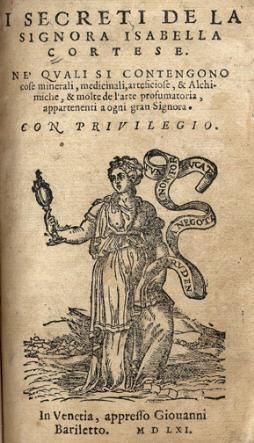Isabella Cortese facts for kids
Isabella Cortese (who was active around 1561) was a smart Italian alchemist and writer during the Renaissance period. We know about her life and work mostly from her famous book about alchemy, called The Secrets of Lady Isabella Cortese.
Isabella Cortese was skilled in many areas, not just alchemy. She created different facial cosmetic products and made other important contributions to science in the 1500s.
Contents
Science in 16th-Century Italy
During the 1500s, science became very popular in Italy. People were excited about learning how to change nature and discover "secrets" for many uses. These included cosmetics, alchemical changes, and medical treatments.
In those times, the words "secret" and "experiment" meant almost the same thing. A "secret" wasn't something unknown. Instead, it was something that had been proven to work. In the 1500s, a secret could even be used like money! People could use secrets to pay debts or trade them. Knowing secrets could also make someone more respected and important in society.
As more people wanted to learn these secrets, they became popular with both men and women. More women were learning to read in the 1500s because books were becoming easier to find. "Books of secrets" were special because they were enjoyed by people from all social classes. These books helped science reach many more people than before.
Isabella Cortese's book, I secreti della signora Isabella Cortese, became very famous. By 1599, her book had been printed seven times! This made her known as one of the "Professors of Secrets."
Women in 16th-Century Science
In the 1500s, women were still working to gain a stronger role in science. While men mostly led fields like medicine, women often had special knowledge about their own bodies. This led to women writing "books of secrets" that shared their knowledge.
However, some people still doubted if women could truly understand science. So, books about women's cosmetic and medical remedies were often published under a woman's name. This made them seem more trustworthy to other women, even if some men didn't value them as much.
The "secrets" in these books were like recipes for different cosmetic and medical uses. Isabella Cortese's book was easy to follow. It gave step-by-step instructions, making it simple for women to read and use. These helpful guides were also translated into many languages. This meant women from all over the world could read these "books of secrets."
Isabella Cortese's Education
Isabella Cortese said she studied alchemy for 30 years. She looked at the works of famous alchemists like Geber, Ramon Llull, and Arnold of Villanova.
However, she didn't think much of their work. She called it "complete gibberish" and "crazy recipes." She felt she had learned nothing useful from them. In fact, she believed studying their books only increased her "likelihood of an early death." It is said that Isabella Cortese learned more about alchemy by traveling the world than by just reading old books.
The Secrets of Lady Isabella Cortese Book
Isabella Cortese's book, I secreti della signora Isabella Cortese, was first printed in Venice in 1561. This book helped introduce alchemy to many more people. It was part of a popular type of book called "books of secrets."
The "secrets" in Isabella Cortese's book are similar to what we call "experiments" today. Many of them were considered proven medical treatments and everyday cures. If an experiment was very successful, it could be traded or used to pay debts. It could even help someone move up in society.
Besides medical and cosmetic remedies, the book also gave advice on how to manage a household. It even discussed how to try and turn regular metal into gold! The book included instructions for making many useful items. These included toothpaste, glue, polish, soap, and cosmetics.
One special treatment in the book combined camphor, quicksilver (liquid mercury), and sulfur. This mixture was supposed to create a "universal medicine." The book claimed that if all instructions were followed exactly, the reader would learn all its secrets. The book shared a lot about unknown parts of nature and how they could be used for health.
Isabella Cortese's Cosmetic Recipes
Isabella Cortese's book includes some very interesting recipes. Even though she worked in alchemy, she also focused on cosmetic changes for the female body. This is much like what we call cosmetology today. These transformations used ingredients that might seem strange to us now.
For example, one recipe for face color involved white-feathered birds. First, you would feed these birds only pine nuts for one to two weeks. Then, you would butcher the birds. The liquid and some parts of the bird were mixed with a little sweetbread and white bread. Next, some goat's milk was added, and the mixture was heated. Finally, the product was distilled and applied to the face. This was supposed to improve a pale complexion and show one's true skin tone.
Another recipe in her "book of secrets" was for cleansing and detoxifying the face. First, you would gather dried lemon beans. These were mixed and added to a container of white wine. Then, you would add some honey, a few eggs, and a couple of ounces of goat's milk. All these ingredients were combined and then distilled. This final mixture could be applied to help remove toxins and harmful chemicals from the face.
These are just two of the most unique recipes linked to Cortese. Whether these recipes "worked" depended on the beauty standards of 16th-century Europe. Today, cosmetology deals with many different skin tones, skin types, hair textures, and beauty ideas from people all over the world.
See also
 In Spanish: Isabella Cortese para niños
In Spanish: Isabella Cortese para niños


